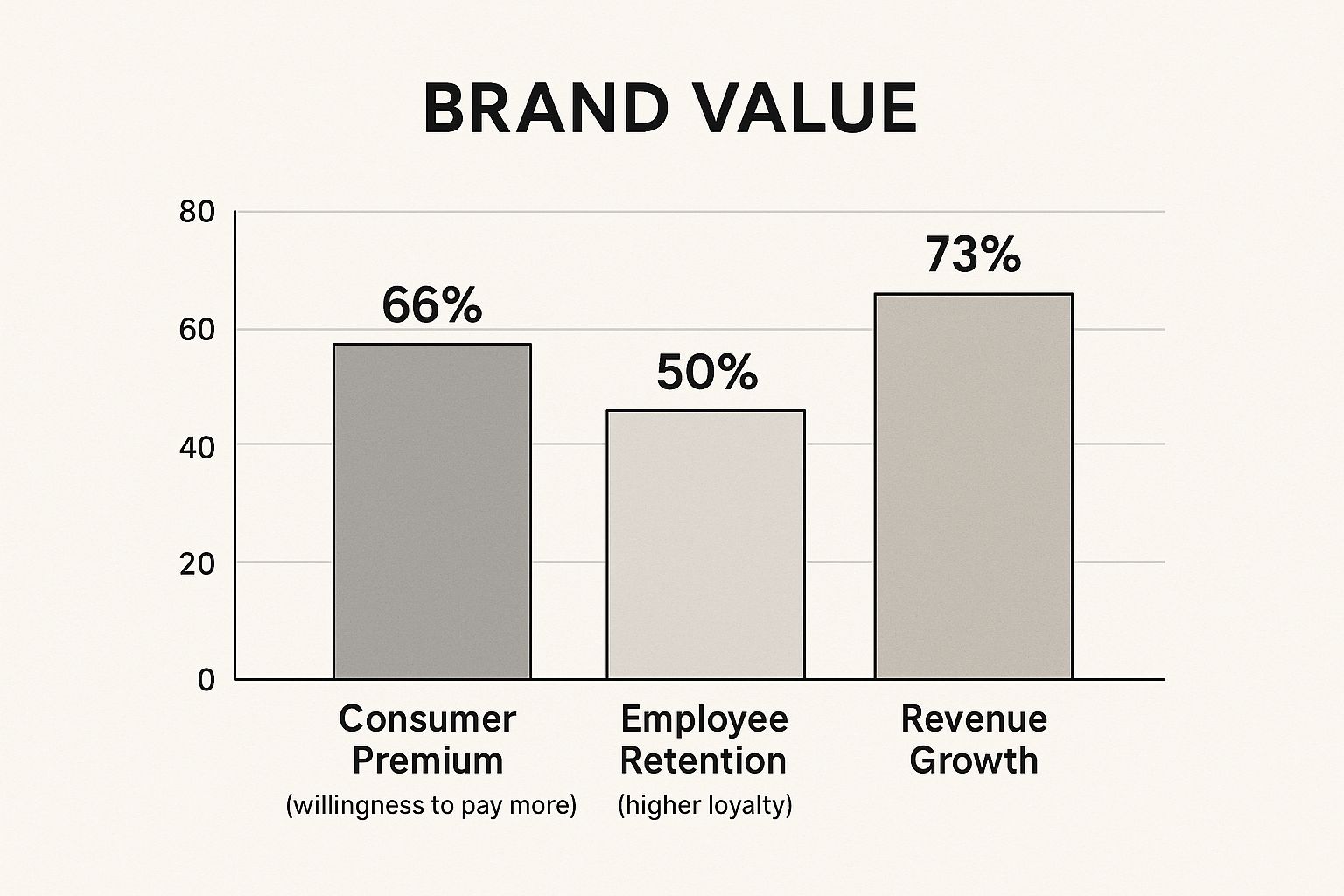What Truly Makes a Purpose-Driven Brand Stand Out
Beyond catchy slogans and performative Corporate Social Responsibility (CSR), what truly sets a purpose-driven company apart? It all comes down to authenticity and integration. A purpose-driven brand isn't about empty words; it's about aligning actions with values at every level. This deep commitment to a purpose beyond profit resonates with today’s values-driven consumers.
Beyond the Buzzwords: Authentic Purpose
A truly purpose-driven brand begins with a clearly defined mission that transcends simply selling. This mission should address a real-world need, guiding all business decisions. For example, Patagonia’s commitment to environmental sustainability influences everything from product design to their advocacy, creating a cohesive brand narrative.
The Power of Consumer Trust
Purpose-driven branding fosters strong consumer loyalty and trust. 76% of consumers choose brands they trust, even when cheaper options are available. This trust grows when a brand’s values align with its customers’, creating a powerful connection. Find more detailed statistics here This transforms customers into brand advocates.
Integrating Purpose Throughout the Brand Experience
Purpose must be woven into the brand's very fabric. This means integrating it into every touchpoint, from product development and marketing to employee engagement and the supply chain. This holistic approach ensures the brand's purpose is an integral part of its identity, not just a marketing tactic.
Communicating Purpose Effectively
Authentic communication requires transparency and genuine storytelling. Brands must showcase their tangible impact, avoiding vague statements. This might involve sharing stories of positive social or environmental change, highlighting ethical sourcing, or showcasing employee volunteer work. Actions speak louder than words.
Walking the Walk: From Purpose to Action
Ultimately, a purpose-driven brand stands out through its unwavering commitment to action. This means setting measurable goals, tracking progress, and holding themselves accountable for real-world results. By demonstrating genuine impact, these brands build trust, foster loyalty, and inspire. They understand that purpose is a business imperative, not just a marketing strategy.
The Surprising Business Case for Purpose-Led Branding
Forget the outdated notion that purpose and profit are at odds. A purpose-driven brand, one that genuinely connects its work with a mission beyond the bottom line, can be a powerful force for growth and standing out in the market. This isn't about fleeting feel-good moments; it's about tangible, measurable business results.
The Impact on Key Metrics
Integrating purpose significantly influences key performance indicators (KPIs). It's not just about doing the right thing; it's about succeeding because of doing the right thing. From acquiring customers to keeping employees, purpose-driven brands see remarkable improvements. The following infographic visualizes the positive impact of purpose-driven branding across three crucial metrics: consumer premium, employee retention, and revenue growth.

As the infographic shows, purpose-driven companies benefit from a 66% consumer premium (customers willingly pay more), enjoy 50% higher employee retention (reducing recruitment and training expenses), and experience 73% revenue growth compared to their less purpose-focused competitors. These compelling results highlight the significant influence of a strong purpose in achieving business success.
To further illustrate the impact of purpose-driven branding, let's examine a comparison of key performance indicators between purpose-driven brands and traditional brands.
The following table, "Purpose Driven Brands vs. Traditional Brands", compares key performance indicators between businesses with a defined social mission and those without.
| Performance Metric | Purpose Driven Brands | Traditional Brands | Difference |
|---|---|---|---|
| Consumer Premium | 66% | 0% (Baseline) | +66% |
| Employee Retention | 50% higher | Baseline | +50% |
| Revenue Growth | 73% | Baseline | +73% |
This table clearly demonstrates the significant advantages enjoyed by purpose-driven brands across these key performance indicators. The differences highlight the potential for increased profitability, a more engaged workforce, and stronger customer loyalty.
Attracting and Retaining Top Talent
Purpose-driven brands act as powerful magnets for talented individuals. In today's competitive talent landscape, employees increasingly seek companies whose values resonate with their own. This allows purpose-driven organizations to attract and retain the best and the brightest, nurturing a culture of dedication and innovation. This, in turn, leads to a more productive and fulfilled workforce, ultimately contributing to a healthier bottom line.
Building a Resilient Customer Base
These brands also cultivate deep customer loyalty. When consumers connect with a brand's mission, they evolve from mere customers into passionate advocates. This creates a resilient customer base, better equipped to weather market volatility and competitive pressures. This translates to reduced customer acquisition costs and increased lifetime value.
Long-Term Growth and Differentiation
Moreover, purpose-driven branding provides a sustainable, long-term strategy for growth. It's more than a passing trend; it's a foundation for lasting success and differentiation. In the coming years, companies that weave social responsibility, sustainability, and innovation into their brand narrative are poised to flourish. For instance, a report by Edelman reveals that 74% of global consumers prefer brands championing gender equality and actively supporting women in leadership. Learn more about this forward-thinking approach in this article about marketing in 2025. This long-term vision appeals to investors seeking companies committed to both profit and a higher purpose.
Measuring Purpose-Related ROI
It's essential to remember that the advantages of purpose-driven branding aren't always immediately visible. Tracking and measuring the return on investment (ROI) of purpose initiatives is key. This may involve monitoring metrics such as customer lifetime value, employee engagement, and brand reputation. By showcasing a clear connection between purpose and profit, brands can address stakeholder concerns and secure support for future purpose-led endeavors. This data-driven approach strengthens the business argument for purpose and ensures its continued integration within the overall brand strategy.
Uncovering Your Brand's Authentic Purpose
Finding your brand's true north goes beyond simple brainstorming. It requires a deep dive into the heart of your values and the positive impact you envision for the world. This section offers a practical roadmap to discover a purpose that resonates both within your team and with your audience.
Defining Your "Why"
A purpose-driven brand begins with a clearly defined "why"—the reason your brand exists beyond simply making a profit. Forget catchy slogans; this is about identifying the genuine need your brand fulfills. This purpose becomes the guiding star for every decision, shaping your product development, marketing strategies, and overall brand experience.
Conducting Purpose Discovery Workshops
Purpose discovery workshops bring key stakeholders together to explore your brand's core values and aspirations. These collaborative sessions can unearth shared beliefs and common ground, forming the very foundation of your purpose. Think of these workshops as uncovering the bedrock upon which your brand's purpose will be built.
The Power of Stakeholder Interviews
A truly successful purpose-driven brand requires commitment at every level, starting with executive buy-in. Furthermore, interviewing employees, customers, and even suppliers offers invaluable perspectives. These diverse viewpoints create a well-rounded understanding of your brand's perception, revealing hidden opportunities to align your purpose with the needs of all your stakeholders.
Heritage Analysis: Learning From the Past
Reflecting on your brand's history—its origins, evolution, and milestones—can illuminate your authentic purpose. This heritage analysis helps identify recurring themes and values that have molded your brand over time, providing a strong base for defining your purpose moving forward. Much like the rings of a tree tell its story, your brand’s history reveals its intrinsic purpose.
From Purpose Confusion to Crystal Clarity
The journey from uncertainty to a well-defined purpose can be complex. Many brands struggle to articulate their "why" authentically and meaningfully. However, by integrating these methods—workshops, interviews, and heritage analysis—you can distill your brand's essence into a compelling purpose statement.
Evaluating Your Current Purpose
Even with an existing purpose statement, regular evaluation is vital. Ask yourself these key questions:
- Does our purpose resonate with our employees and customers?
- Does it influence our daily operations and decisions?
- Does our purpose set us apart in the market?
If the answer to any of these is "no," it might be time to re-examine your purpose. Ensure it aligns with your current capabilities and long-term vision. This continuous reflection keeps your brand aligned with its authentic purpose and avoids the trap of inauthenticity.

Embedding Purpose Throughout Your Brand Experience
Building a truly purpose-driven brand takes time. It's about carefully weaving your core values into every aspect of your business, creating a cohesive and genuine experience for your customers. This isn't just about stating your purpose; it's about truly living and breathing it.
From Statements to Tangible Actions
Turning purpose statements into tangible actions is critical. This involves aligning your products, services, and operations with your core "why." For example, if sustainability is your purpose, everything from your packaging and sourcing to your manufacturing processes should reflect this commitment. This alignment between words and actions builds trust and reinforces your brand identity.
Empowering Employees as Purpose Ambassadors
Your employees are your greatest asset. Empowering them to embody and champion your brand's purpose expands its influence. Think about implementing training programs centered around your brand values, or encourage employee-led initiatives that align with your purpose. When your team genuinely believes in your mission, that passion is infectious, impacting every customer interaction. This fosters a culture of purpose that radiates outwards.
Aligning Policies and Decision-Making
Every business decision, from product development to marketing strategies, should be guided by your purpose. Establishing purpose-aligned policies provides a framework for consistent decision-making. This guarantees all actions reinforce your mission, building integrity and fostering long-term customer trust. This clear framework eliminates ambiguity and promotes consistency across every department. For new businesses, a strong branding strategy for startups is key, ensuring it resonates with your fundamental values.
Building a Purpose-Driven Supply Chain
Your supplier relationships are important too. Selecting partners who share your values extends the reach of your purpose beyond internal operations. If your brand is committed to fair labor practices, for instance, your suppliers should uphold the same ethical standards. This comprehensive approach enhances authenticity and creates a stronger, more values-aligned network around your brand.
Maintaining Purpose Integrity During Transitions
A truly purpose-driven brand stays true to its mission, even through challenges or leadership changes. Creating robust governance systems ensures your core values are preserved and continue guiding the business, no matter the circumstances. This steadfast commitment strengthens your authenticity and builds a reputation as a truly purpose-driven organization. This long-term vision provides stability and reinforces your brand's commitment to its core "why," cultivating enduring trust with your customers.

Communicating Purpose That Resonates, Not Alienates
Authenticity is key. Even the most genuine purpose can fall flat if it isn't communicated effectively. A purpose-driven brand needs to articulate its mission with clarity and passion, avoiding the impression of virtue signaling. This means creating relatable stories that demonstrate real impact, without exaggeration.
Crafting Compelling Purpose-Driven Narratives
Storytelling is the heart of effective communication. Instead of simply stating your purpose, bring it to life through real-world examples. Share stories about the positive changes your brand is making, focusing on the people and communities you're impacting. For example, instead of claiming to be "eco-friendly," show the concrete actions you've taken to minimize your environmental impact, such as using sustainable materials or reducing waste.
Channel-Specific Communication Strategies
Different platforms call for different approaches. Instagram might be perfect for visually showcasing your impact through images and short videos, while LinkedIn might be better for sharing thought leadership pieces about your purpose-driven practices. Instagram offers a vibrant visual platform, whereas LinkedIn provides a space for professional discourse. This tailored approach ensures your message connects with the specific audience on each platform. Consider these examples:
-
Social Media: Engage emotions through visuals and compelling stories.
-
Website: Clearly articulate your mission and values on a dedicated page.
-
Email Marketing: Share regular updates on your purpose-driven initiatives and the impact you're making.
-
Public Relations: Generate media coverage that highlights your positive contributions to society.
To help you choose the right channel, here's a table summarizing the effectiveness of different communication channels for purpose-driven messaging:
Purpose Communication Channels Effectiveness
Analysis of different communication channels for purpose-driven messaging and their effectiveness with various audience segments
| Communication Channel | Effectiveness Score | Best For | Common Pitfalls |
|---|---|---|---|
| Social Media | High | Visual storytelling, emotional connection | Superficial engagement, fleeting attention spans |
| Website | Medium | Detailed explanations, building trust | Requires consistent updates and SEO optimization |
| Email Marketing | Medium | Direct engagement, sharing updates | Can feel intrusive if not targeted correctly |
| Public Relations | High | Building credibility, reaching wider audiences | Difficult to control messaging, can backfire |
This table highlights how different channels can be effective depending on your specific goals and target audience. Understanding these nuances will ensure your message truly lands.
Addressing Skeptical Audiences
Transparency builds trust. Not everyone will instantly embrace your brand's purpose. Some may be skeptical, suspecting it's merely a marketing ploy. To counter such concerns, transparency is essential. Openly share your progress, the challenges you face, and even your setbacks. This honesty demonstrates genuine commitment and builds trust with your audience. Whenever possible, back up your claims with data and evidence.
Maintaining Message Consistency Across Stakeholders
Consistency is paramount. While your core purpose should remain steadfast, your messaging may need to be adjusted for different stakeholders. Investors may be more interested in the financial returns of your purpose-driven approach, while employees might be drawn to the chance to make a meaningful difference. Maintaining consistency in your core message while tailoring its delivery ensures it resonates with each audience.
Navigating Sensitive Social Moments
Empathy and action go hand-in-hand. During periods of social or political unrest, communicating your purpose demands careful consideration. Avoid appearing opportunistic or exploiting sensitive situations for marketing gains. Focus on genuine empathy and support, ensuring your actions align with your stated values. This demonstrates authentic commitment and prevents accusations of insincerity.
Responding to Purpose-Related Criticism
Constructive engagement fosters growth. Even with the best intentions, a purpose-driven brand might face criticism. Respond constructively by acknowledging concerns and outlining the steps you're taking to address them. This shows a willingness to listen and learn, reinforcing your commitment to transparency and authenticity. View criticism as a chance to refine your approach and make a greater impact.
Measuring What Matters: Purpose Impact Metrics

A purpose-driven brand thrives on more than just good intentions. It needs a strong foundation built on measurable impact. Without data, purpose can become superficial, lacking real substance. Tracking and evaluating the effects of your purpose initiatives is absolutely essential. This section explores effective methods for measuring both the business and social impact of your brand's purpose.
Key Performance Indicators (KPIs) for Purpose
Just like any sound business strategy, a purpose-driven approach requires measurable objectives. Key performance indicators (KPIs) provide the concrete data necessary for assessing progress. These KPIs can range from standard business metrics, like revenue and customer acquisition cost, to specialized metrics designed to capture social impact.
For instance, if your brand focuses on environmental sustainability, consider these KPIs:
- Reduction in carbon emissions
- Percentage of recycled materials used
- Decrease in water consumption
Tracking these KPIs provides tangible proof of your dedication to purpose. This data-driven approach validates the importance of purpose within your business and paves the way for its long-term integration.
Balanced Scorecards: Integrating Purpose and Profit
While social impact is paramount for a purpose-driven brand, financial viability remains critical. Balanced scorecards offer a way to integrate both by monitoring financial metrics alongside purpose-driven goals. This creates a comprehensive view of your brand's performance, highlighting how purpose contributes to overall success. A balanced scorecard might, for example, track revenue growth alongside the number of people positively affected by a social initiative.
Establishing Baselines and Setting Realistic Targets
Measuring progress starts with establishing clear baselines. Understanding your starting point for each KPI is crucial. Once baselines are set, define achievable, yet aspirational targets. This creates a practical roadmap for measuring progress and celebrating milestones. If, for example, your baseline customer satisfaction is 70%, a realistic target might be to reach 75% within a year.
Continuous Improvement: The Cycle of Measurement and Refinement
Purpose is not static; it grows and evolves. Regularly review your chosen metrics and adjust your strategies as needed. This continuous cycle of improvement keeps your brand aligned with its core purpose and amplifies its impact. This may involve refining your messaging, developing new partnerships, or even reevaluating your purpose statement as your brand develops.
Communicating Purpose-Related Achievements
Sharing your successes is vital, but avoid exaggerating your impact. Prioritize transparency and authenticity, backing up your claims with clear data. This builds trust and credibility, showcasing your genuine dedication to your purpose. Be prepared to address setbacks or challenges openly. This honesty reinforces your authenticity and deepens your connection with your audience.
Warning Signs of Misaligned Purpose Measurement
Sometimes, purpose measurement can get off track. Be mindful of these potential pitfalls:
- Focusing solely on vanity metrics: While likes and shares can be gratifying, they don't always represent true impact.
- Lack of connection between metrics and purpose: Ensure your KPIs directly relate to your core purpose.
- Ignoring negative feedback or data: Embrace constructive criticism and use it to refine your approach.
Recognizing these potential issues ensures your purpose measurement stays true to your brand’s mission. This ongoing vigilance safeguards the authenticity of your purpose and strengthens its role in your overall brand strategy.
Ready to define your purpose and build a brand that resonates? Discover how Henri Den can help you unlock your brand's potential and create a lasting impact.






